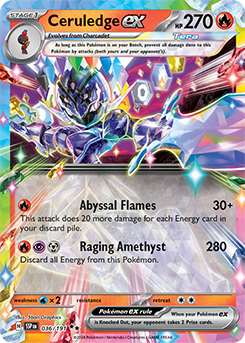Read on below to learn more about the new Surging Sparks expansion as part of Pokémon TCG: Scarlet & Violet.
Can you smell what Ceruledge ex is cooking?
By Natalie Millar, Contributing Writer
The launch of the Scarlet & Violet—Surging Sparks expansion has put focus on Pikachu ex—with good reason. While it may not be quite as electrifying as the latest iteration of the Mouse Pokémon, Ceruledge ex also deserves plenty of attention. Its Abyssal Flames attack is being compared to a superstar from the past: Victini Prism Star’s Infinity attack, which does 20 damage for each Basic Energy card in your discard pile (and then shuffles those cards into your deck).
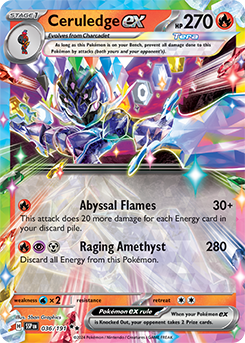
While the attacks may seem similar on the surface, Abyssal Flames is an upgrade: It allows you to keep the Energy in your discard pile and keep adding to the damage count each turn. It does a base of 30 damage plus 20 more for each Energy card in the discard pile (including Special Energy). To see the full power of Abyssal Flames, spend the game discarding Energy to build up to Ceruledge ex doing massive damage at the end of the game!
When building this Ceruledge ex deck, I focused on playing ways to draw through my deck quickly to harness the might of the Pokémon and its blistering attack. PokéStop immediately came to mind as an important card: it lets you both discard cards (typically Energy cards) from your deck and find important Item cards, like Earthen Vessel, which helps find and discard the Energy needed to power Abyssal Flames. Professor’s Research seemed like a very strong Supporter card for this deck, so I initially had the full four copies. That was too many, though: I had to stop drawing cards because I frequently came close to losing the game by running out of cards in the deck. After retreating a little bit on my strategy of trying to draw my entire deck by turn three, I came to the deck list below. Now, let’s take a look at how I built a fire deck that harnesses the heat of Ceruledge ex and Abyssal Flames!
Ceruledge ex
Pokémon (13)
- 4Ceruledge ex 36/191
- 4Charcadet 32/191
- 1Fezandipiti ex 38/64
- 1Iron Bundle 56/182
- 1Mew ex 151/165
- 1Radiant Greninja 46/189
- 1Squawkabilly ex 169/193
Energy Cards (20)
- 18Fire Energy
- 2Mist Energy
Trainer Cards (27)
- 3Professor’s Research (Professor Sada)
- 1Boss’s Orders (Ghetsis)
- 1Briar
- 1Iono
- 3PokéStop
- 4Earthen Vessel
- 4Nest Ball
- 4Night Stretcher
- 4Ultra Ball
- 1Pal Pad
- 1Prime Catcher
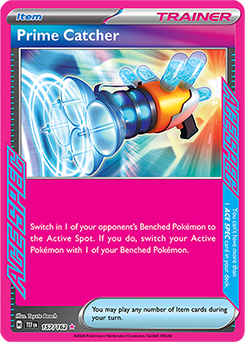
The goal of this deck is to quickly do as much damage as possible with Abyssal Flames. To do this, I needed a way to feed the discard pile to power up Ceruledge ex. With PokéStop, Professor’s Research, Squawkabilly ex, and four Earthen Vessel—and especially with Radiant Greninja’s Concealed Cards Ability—I found it easy to hit over 200 damage on turn two with Abyssal Flames. But it took a few failed experiments for me to get there.
At first, I tried to use ACE SPEC Brilliant Blender to help with discard. But I found it easier to include additional Energy cards and Earthen Vessels that let me play Prime Catcher, which is one of the strongest cards available in the current format. Prime Catcher is this deck’s only form of switching, and while that can seem scary, it is fine if you attach Energy every turn. Excluding Ceruledge ex (which you want in the Active Spot most of the time), the other Pokémon have a Retreat Cost of 1.
Legacy Energy was another ACE SPEC that I considered: it could force opponents to have to go through four Ceruledge ex. However, Legacy Energy isn’t searchable, meaning you’d be very reliant on having it in play at exactly the right time. So, I decided to include Prime Catcher instead as an easy way to bring up an opposing Benched Pokémon.
I also experimented with using Carmine initially. However, even though you are opting to go first in every matchup, Squawkabilly ex gives you a very similar effect. Carmine is significantly weaker than Professor’s Research after the first turn of the game, and I’d likely have to play a Lumineon V to help me find it on the first turn anyway. Plus, I would rather play a second Squawkabilly ex in that space.
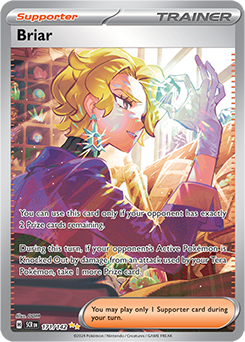
Once I started playing, this deck seemed very similar to Raging Bolt ex / Teal Mask Ogerpon ex decks in that it was just trying to take one-hit Knock Outs every turn of the game. The main difference between these decks is that Ceruledge ex is a Stage 1 Pokémon while Raging Bolt ex is a Basic Pokémon, which lets Raging Bolt ex attack on its first turn when going second. Ceruledge ex’s Stage 1 status means I’d need to go first every game and try to get a Charcadet in my Active Spot on turn one. If successful, I could limit my opponent to only taking one Prize card initially—and it could let me take two Prize cards every turn afterward and hopefully win the Prize trade quickly! This deck also plays similarly to Gholdengo ex decks, although discarding all of your Energy is slightly easier than getting it into your hand, even though Ceruledge ex has no draw power built into it.
This deck is significantly worse off when going second, so I tried using Scream Tail ex with multiple Jet Energy to try and stop opponents from using a Supporter card on turn two and to stunt them during setup. In the end, I chose not to include Scream Tail ex in this deck list. Instead, I preferred sticking a Charcadet in the Active Spot, even when going second, to try and force my opponent to take a single Prize card. If you do decide to include Scream Tail ex, I would remove the two copies of Mist Energy, two copies of Fire Energy, and Iron Bundle. I would then replace them with the Scream Tail ex and four Jet Energy.

While playing 20 Energy cards might look a little silly, this deck requires sending a ton of Energy to the discard pile with PokéStop, Professor’s Research, Ultra Ball, Squawkabilly ex, and Radiant Greninja. Discarding so many cards can have adverse effects, which I especially felt when I only played three copies of Ceruledge ex. Four copies helped with the problem of discarding too many of them, but I also added four Night Stretcher to help recover both Ceruledge ex and other important Pokémon, such as Fezandipiti ex and Mew ex. Night Stretcher also comes in handy when reusing Iron Bundle’s Hyper Blower Ability.
Because Ceruledge ex is a Tera Pokémon, you also get to include a copy of Briar for when your opponent gets down to two Prize cards. While you can’t manipulate your opponent’s Prize cards like with Dusknoir decks, having the option to use Briar can be nice. I also chose to include one copy each of Boss’s Orders and Iono (even though you mostly want to play Professor’s Research), because these Supporters give extra options to Knock Out opposing Pokémon on the Bench or to disrupt your opponent’s hand. I also chose to play a copy of Pal Pad to help recover these Supporters if they get discarded off a PokéStop or if you need to refresh your hand.
While this does look like the type of deck where Trekking Shoes would fit right at home, I found that I was able to draw through the deck and discard enough Energy without it. This allowed me to dedicate other spots in the deck to more Energy cards and different consistency cards, allowing enough Energy to enter the discard pile for Abyssal Flames to take one-hit Knock Outs on Charizard ex or Dragapult ex. I also gave Buddy-Buddy Poffin a go but removed it after a few games. I found that with Professor’s Research, I was able to get enough Charcadet into play and didn’t need the extra search.

As I was playing Ceruledge ex, it became clear that I would need to make many interesting sequencing decisions. My main concerns were when to attach an Energy for the turn, when to use Concealed Cards, and when to play Earthen Vessel to thin Energy. I typically went with the decisions that resulted in the greatest number of Energy cards entering the discard pile; I often discarded Energy with Squawk and Seize or Professor’s Research before attaching for the turn or using Concealed Cards with the hope of drawing into extra Energy.
My initial deck list played two copies of Squawkabilly ex. However, I later branched out to one copy of Squawkabilly ex and one copy of Mew ex—a smart inclusion thanks to its Restart Ability. With two Squawkabilly ex, I found that I had Bench spaces open for most of the game, even if I had Radiant Greninja, a backup Charcadet, and Fezandipiti ex. While the Parrot Pokémon’s free Retreat Cost can be nice, I often found myself using up my spare Energy attachments to retreat my Pokémon to get extra Energy into the discard pile. That was especially true when my opponent was targeting support Pokémon, such as my Fezandipiti ex or Radiant Greninja, over my star player Ceruledge ex, which meant I didn’t need to use the attachment for a turn to power up Abyssal Flames.
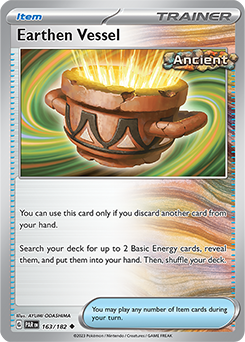
When it came to the timing of playing Earthen Vessel, my decision often depended on whether I was going to use PokéStop that turn. If I was using PokéStop, then I would typically use Earthen Vessel afterward to increase the chance of discarding Energy via PokéStop. My decision also depended on whether I needed an Item card that turn or had other discard outlets in hand (like Ultra Ball). If you have an Earthen Vessel in hand and are thinking about thinning your Energy before using Concealed Cards, consider first whether you need to draw Energy soon, whether you need to attach it during that turn, and whether you have any discard outlets in hand. There is no hard and fast rule for when to thin your deck: what matters is what you want to draw to execute your ideal turn.
All in all, Ceruledge ex is one of the most promising decks that I’ve tried from Scarlet & Violet—Surging Sparks. It does play similarly to other decks that try to do a ton of damage to your opponent’s Active Pokémon, but once you discard the Energy, it takes less to set up future Ceruledge ex. Truly, this red-hot deck has a ton of stability. Give it a shot—it’s a ton of fun to burn through your deck and do massive damage!
Natalie Millar

Natalie has been playing Pokémon casually since late 2013 but started attending more competitive tournaments in late 2017. She won the first Regional Championships after the pandemic in her home city of Brisbane, Australia, and has been attending most major tournaments since. Outside of Pokémon, she studied psychology, but it doesn’t help with reading opponents as much as you would think. You can find her at most major tournaments and can follow her on X at @nataliem9999.
Source: Pokemon.com
Source: Pokemon

